Science Highlights, August 19, 2015
Awards and Recognition
Earth and Environmental Sciences
African Technopolitan Magazine features article by Giday WoldeGabriel
Science on the Roadmap to MaRIE
PHELIX at pRad enhances movie-making of materials in extreme environments
Awards and Recognition
President of Poland awards Piotr Zelenay National Professorship In Chemistry
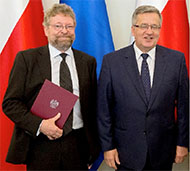
Photo. Piotr Zelenay (left) receives award from Poland’s President Bronislaw Komorowski. Source: Wojciech Olkuśnik, Chancellery of the President of the Republic of Poland.
Piotr Zelenay (Materials Synthesis and Integrated Devices, MPA-11) received the honorary title of Professor in Chemistry from Poland’s President Bronislaw Komorowski during a June 23 ceremony in the Presidential Palace in Warsaw. The highly respected title of Professor, conferred by the president upon a motion of the Central Commission for Academic Degrees and Titles, may be awarded to those who have earned a degree of habilitated doctor (a degree above a Ph.D.); have achievements exceeding those required for the habilitated doctor degree; and who have an excellent record in education.
Zelenay earned doctoral and doctor of science (“habilitation”) degrees in chemistry from the University of Warsaw, where he later served as a professor. He joined Los Alamos as a technical staff member in 1997. He is world-recognized in the area of inexpensive, nonprecious metal electrocatalysts intended to replace platinum in polymer electrolyte fuel cells for use in electric vehicles. Since becoming project leader for the Laboratory’s Fuel Cell Program in 2000, Zelenay has led numerous research projects totaling nearly $60 M in research funding.
Zelenay has published more than 150 articles in scientific journals, including Nature, Science, Chemical Reviews, and Accounts of Chemical Research. He has 18 patents and patent applications in polymer electrolyte fuel cells. Honors include a LANL Fellows Prize for Outstanding Research, Electrochemical Society fellowship, Electrochemical Society Energy Technology Division Research Award, and a DOE Hydrogen Program R&D Award. He is an affiliate professor at the University of Warsaw, an editorial board member of Electrocatalysis, and a steering committee board member for the International Academy of Electrochemical Energy Science. Technical contact: Piotr Zelenay
Carlos Tomé selected for plasticity research medal
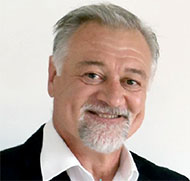
Carlos Tomé
The International Journal of Plasticity will honor Carlos Tomé (Materials Science in Radiation and Dynamics Extremes, MST-8) with the Khan International Medal during the 2016 International Conference on Plasticity, Damage and Fracture in Hawaii. The journal recognized him for his “outstanding life-long contributions in the field of plasticity.”
Tomé will deliver a plenary lecture, “Recent Advances in Modeling the Constitutive Response of Aggregates,” at the upcoming conference and will write a review paper for the journal. A mini-symposium, “Stochastic Information in Characterization and Modeling of Mechanical Behavior,” will be organized in his behalf for the 2017 International Plasticity Conference, and a special issue of the journal will include the symposium presentations.
Upon hearing of his award, Tomé acknowledged his work with DOE Basic Energy Sciences, the Consortium for Advanced Simulation of Light Water Reactors, and the Advanced Simulation and Computing Program that provided the “continuity, exposure, and interactions with first-class researchers,” which he said made possible his contributions to the field of plasticity.
Tomé earned a PhD in physics from the National University of La Plata, Argentina, and joined the Laboratory in 1996. He pioneered the theoretical and numerical development of physically based modeling of mechanical behavior of polycrystals, with a focus on the role played by texture, twinning, and microstructure on the anisotropic properties of engineering and geologic materials. Such approaches have led to revolutionary changes in how simulations and interpretation of measurements on mechanical behavior are conducted. Material scientists and engineers in academia, national laboratories, and industry use his theories, models, and numerical codes.
Tomé has published more than 170 papers in international journals, with more than 11,500 citations, and he co-authored the books Texture and Anisotropy and Fundamentals and Engineering of Severe Plastic Deformation. He received the 2013 Distinguished Scientist/Engineer Award presented by the Structural Materials Division of The Minerals, Metals & Materials Society (TMS). His work was the focus of a 2011 TMS symposium, the proceedings of which are compiled in a special issue of Modeling and Simulation in Materials Science and Engineering.
The Khan International Medal is named after International Journal of Plasticity Editor-In-Chief Akhtar Khan. The committee selects people they regard as having produced work that influences future research directions in the mechanics of materials. Technical contact: Carlos Tomé
Hai Ah Nam to chair Supercomputing Conference Student Cluster Competition
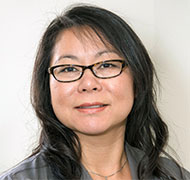
Hai Ah Nam
Since volunteering for her first Student Cluster Competition in 2007, Hai Ah Nam (Computational Physics and Methods, CCS-2) has been an active member of the event’s organizational team and has served as the Student Cluster Competition chair in 2010. She will chair the Student Cluster Competition during the 27th annual Supercomputing Conference this November in Austin, TX. Conference participants include scientists, engineers, researchers, educators, programmers, system administrators and developers.
More than 10,000 high-performance computing professionals and students from all over the world attend the Supercomputing Conference annually, including the Student Cluster Competition. Students compete to build and operate powerful cluster computers – smaller versions of high-capacity supercomputers. The students also receive training beyond what they are able to get through their universities and unique networking opportunities. These valuable experiences could lead to new career paths and careers in high performance computing. A degree in computer science alone is not always sufficient to enable the students’ aspirations to be achieved. High performance computing systems are becoming more and more complex as they approach exascale. The ability to use such systems efficiently requires that application developers understand how system architecture (software and hardware) impacts their design choices. It also brings computer scientists or computer engineers together with the domain scientists (biology, physics, etc.) to help solve problems. The competition is similar to a small scale version of a career in high performance computing, and it is an excellent recruiting mechanism.
Fidler, Hernandez, Meyers, Stier, Yablinski win Postdoc Research Day Awards
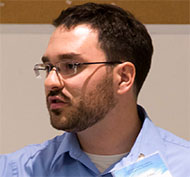
Andrew Fidler
Andrew Fidler, Sarah Hernandez, Lisa Meyers, Andreas Stier, and Clarissa Yablinski have received Postdoc Research Day Awards. The Laboratory-wide event provides postdocs with the opportunity to present a summary of their research, in an environment fostering enhanced collaboration and technical discussions among postdocs, staff, and management. Over 70 postdocs registered to showcase their research. Senior management selected some participants to give a two-minute overview presentation of their research. Technical contact: Mary Anne With Andrew Fidler (Physical Chemistry and Applied Spectroscopy, C-PCS) presented: “Quantifying Carrier Multiplication Yields in Quantum Dot Solids.” Confinement of carriers in semiconductor quantum dots leads to emergent phenomena at the nanoscale, such as new materials with novel optical and electrical properties. Strongly confined nanocrystals enhance carrier multiplication, whereby a kinetically hot carrier may excite additional electrons across the band gap. The appreciable increase in photon to electron conversion could benefit applications in photovoltaics, photocatalysis, and detectors. Most measurements have relied on non-linear optical methods to characterize the multiplication yield in colloidal suspensions rather than the close packed films that are used in devices. Fidler used transient photocurrent measurements with approximately 50-picosecond temporal resolution in conjunction with ultrafast optical excitation to directly monitor the multicarrier populations in the current of conducting films of lead selenide quantum dots. He resolved the presence of multicarrier Auger recombination at low fluence, a direct signature of the presence of the multiplication process. Engineering the film treatment enables the complete dissociation of charges prior to Auger recombination. The device design enabled him to study the effect of an external electric field. The temperature dependence of the transients allowed direct resolution of the mechanisms of charge transport in the films and elucidated the role of film treatment in tuning the electrical properties. Technical contact: Andrew Fidler.

Sarah Hernandez
Sarah Hernandez (Nuclear Materials Science, MST-16 and Metallurgy, MST-6) presented: “Ab Initio Study of Atomic O Adsorption on Pu-Ga Alloy (111) Surfaces.” She implemented all-electron density functional theory to study the adsorption of atomic oxygen (O) on a 3.125 and 9.375 at.% gallium (Ga) stabilized δ-plutonium (Pu) (111) surface. She explored high symmetry on-surface and interstitial adsorption sites, including the O atom placed in different local environments (i.e. oxygen coordinated with/without a Ga atom). Hernandez used full relaxation of the atomic positions of the Pu-Ga slab and O atom, with the inclusion of spin-orbit-coupling applied on the lowest ground state structure. She found that O binds strongly at an on-surface site and prefers to be three-fold coordinated with Pu atoms. However, chemisorption energies are unfavorable when Ga participates in chemical bonding with the O atom. She also discussed geometric analysis and partial density of states. The Laboratory Directed Research and Development (LDRD) Program supported her research. Technical contact: Sarah Hernandez.
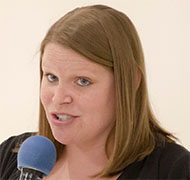
Lisa Meyers
Lisa Meyers (Actinide Analytical Chemistry, C-AAC) presented: “Environmentally Friendly Sample Preparation Methods for Uranium Oxide Dissolution.” Green (environmentally friendly) sample preparation methods are needed to dissolve uranium oxide on swipes for in-field characterization. Ammonium bifluoride (ABF, NH4HF2) has been used as a dissolution reagent for a variety of compounds, including beryllium oxide. Carbonates in the present of an oxidant (NaOCl or H2O2) have originally been used for uranium metal and alloy dissolutions as well as uranium oxides. ABF and CO3 + H2O2 experiments have revealed that these two methods selectively dissolve uranium oxides. Meyers explored bulk uranium oxide dissolution techniques and applied them to swipe media. ABF almost completely dissolves U3O8, and the reagent fully dissolves UO2 within 10 minutes. A CO3 + H2O2 mixture dissolves U3O8. The chemicals included in the reaction are green and less hazardous compared with the strong mineral acids that are most commonly used. The green solvents can be handled and transported during an infield application easily. Technical contact: Lisa Meyers.
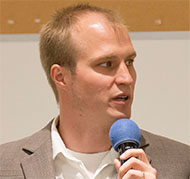
Andreas Stier
Andreas Stier (Condensed Matter and Magnet Science, MPA-CMMS) presented: “Cyclotron Resonance Studies on Topological Insulators in Ultrahigh Magnetic Fields.” The transition of a topological insulator to a trivial insulator has profound effects to the materials bulk band structure, the dispersion relation, and the spin states of the Dirac-like surface states. The details of this topological phase transition are intricate and not well understood. Stier has conducted cyclotron resonance experiments in ultrahigh magnetic fields to reveal how massless Dirac surface states acquire a mass. The multi-split observed resonances suggest a hybridization gap ΔH from the overlap of surface states on opposite surfaces of the sample. This work is relevant to Laboratory programs in electronic materials and the development of dynamic experimentation capabilities. Technical contact: Andreas Stier.
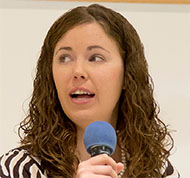
Clarissa Yablinsky
Clarissa Yablinsky (Metallurgy, MST-6) presentation: “Characterization of Irradiation Effects in Nanoscale Stable Precipitation-Strengthened Steels.” High-chromium (Cr) ferritic steels are commonly used in reactor applications. The development of modern oxide dispersion strengthened and nanostructured ferritic alloys via mechanical alloying reveals that ideal microstructural characteristics for irradiation resistance include stable nanoscale precipitates and dislocation sinks. Novel tailored-precipitate ferritic steels and advanced high-Cr ferritic-martensitic steels are being developed using modern materials science concepts and materials design to improve performance. Yablinsky irradiated several newly developed tailored-precipitate ferritic and advanced high-Cr ferritic-martensitic steels with protons at 1.5 MeV to 0.5 dpa and compared with 14YWT (oxide dispersion strengthened/nanostructured ferritic alloys) and P92 (baseline high-Cr ferritic alloy) irradiated under the same conditions. She performed nanoindentation measurements along the incident direction of the proton beam to quantify strengthening due to irradiation. Her transmission electron microscopy studies investigated the irradiated and un-irradiated substructures, specifically the effects of defects and precipitates on strengthening. Technical contact: Clarissa Yablinsky.
Bioscience
GOTTCHA bioinformatics tool developed for metagenome investigation
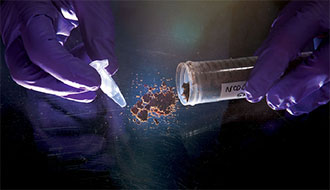
Figure 1. Many molecular biology studies begin with purified DNA and RNA extracted from the soil and other complex environments such as the human gut. Los Alamos researchers have developed a new method for DNA analysis of these microbial communities.
Metagenomics investigates entire microbial communities using genomics, such as sequencing the DNA of a whole community of organisms simultaneously. This produces an enormous data set of short sequences, or “reads,” that researchers must sort through to understand which organisms are actually present, and what they are doing. LANL scientists specialize in analyzing incredibly large data sets and using them to inform research in physics, ocean or climate modeling, and complex biological systems. In a paper in the journal Nucleic Acids Research, Bioscience Division authors described their novel method for shotgun metagenomic read classification that uses nucleic acid data and searches for sections that map uniquely to a preconstructed database. The highly accurate method outperforms many other methods.
The Lab’s semiautomated metagenomic community-profiling tool, named GOTTCHA (Genomic Origins Through Taxonomic CHAllenge), uses a database of reference genomes that have been pre-processed to retain only unique segments of the genomes at any level of taxonomy. Then it classifies the individual metagenome reads. The tool automatically eliminates genomic regions that generate the majority of false-positive signals in existing tools. GOTTCHA analyzes the distribution and depth of coverage of only the unique fraction of each reference genome to identify the true community composition and accurate relative abundance of members of the community. The result is a scalable, all-purpose, metagenomic community profiler with superior classification and statistical performance compared with all currently available tools. Moreover, GOTTCHA is also deployable on a laptop computer.
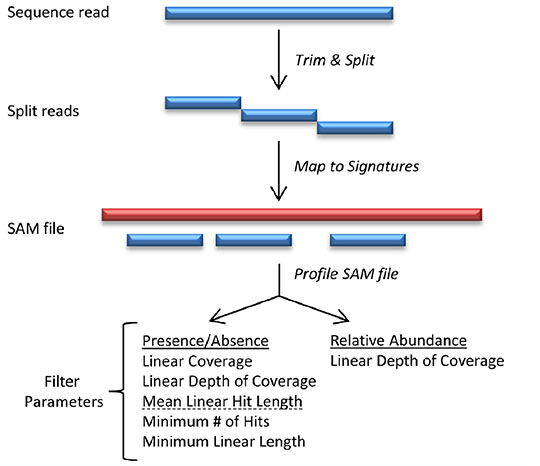
Figure 2. Overview of GOTTCHA workflow. Raw sequence reads are first cut on low quality bases and split into non-overlapping 30 base pair fragments. Read fragments are then mapped to a GOTTCHA database, after which the GOTTCHA profiler parses the alignment file and generates the community composition along with their relative abundances. SAM is sequence alignment file.
GOTTCHA is the first tool that: 1) uses a wide array of synthetic, spiked and real datasets to both train and test the utility of a read-based community profiling method; 2) provides a series of defined and realistic (in amount and quality) metagenome datasets that can be used to re-validate any current or future tools; and 3) addresses the issue of false positives which hampers most other available software. The tool finds bacterial and viral sequences within complex samples, and it makes the method flexible to database search strategies. Moreover, GOTTCHA will continue to improve as genome databases expand.
Accurate and rapid metagenomic community profiling has important applications in both applied and basic science. Clinical diagnosis, exploring fundamental physiogenomic relationships, environmental biosurveillance, agriculture and water quality monitoring, and monitoring bioreactor yields for biofuel production are examples that would all benefit from algorithmic profiling improvements.
GOTTCHA will be a useful resource for analyzing metagenomic data, particularly in diagnostics, where both high false-negative and false-positive rates cannot be tolerated, and where a profile of the relative abundance of certain organisms may be important. This method is an important step to ascertain the presence of potential pathogens in a complex background, such as assessing medically relevant co-infections in clinical samples. Because GOTTCHA uses a unique reference genome databases at each level of taxonomy, researchers can classify never before seen genomes within their respective parent taxonomic groups.
Reference: “Accurate Read-based Metagenome Characterization using a Hierarchical Suite of Unique Signatures,” Nucleic Acids Research 43 (10), e69 (26 May 2015); doi: 10.1093/nar/gkv180.
Authors: Tracey Allen K. Freitas, Po-E Li, Matthew B. Scholz and Patrick S. G. Chain (Bioenergy and Biome Sciences, B-11). The GOTTCHA Tool is available online.
The Department of Defense-Defense Threat Reduction Agency (DoD-DTRA) funded the work, which supports the Lab’s Global Security and Energy Security mission areas and the Science of Signatures science pillar through the ability to identify organisms in complex samples. Technical contact: Patrick Chain
Chemistry
Novel processing techniques for post-nuclear detonation debris analysis
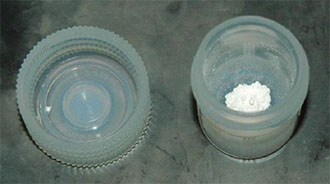
Photo. Final powdered product from the reaction of ABF and SRM (standard reference material) glass, which would subsequently undergo dissolution in 2-3 M nitric acid for elemental analysis.
Analysis of post-detonation nuclear debris is important to elucidate nuclear device design and origin. Existing methods for sample preparation material use large quantities of concentrated mineral acid fluxes and are lengthy (6 to more than 72 hours). LANL researchers investigated a novel approach for nuclear debris processing utilizing solid ammonium bifluoride [(NH4)HF2] for the dissolution of fused glass samples containing actinides and fission products. The team evaluated sample digestion procedures that all employ ammonium bifluoride (ABF) for efficiency, ease of use, and safety.
The team applied thermodynamic modeling to develop, explore, and compare methods for digesting fused glass samples with ABF. The researchers used OLI Systems Software to demonstrate that a majority of the metal oxides in the fused glasses will form fluoride or ammonium fluoride complexes when treated with ABF. Moreover, ABF reacts with the major component of glass, silicon dioxide (SiO2), to produce silicon tetrafluoride (SiF4) gas. At least 50% of the glassy sample evaporates into a gaseous form rather than being incorporated in aqueous waste. Modeling established optimal experimental parameters for the three methods under investigation: microwave assisted digestion, conventional oven dissolution, and hot plate fluxing.
The researchers conducted experiments using National Institute of Standards and Technology glass standard reference materials (SRMs) for both conventional oven dissolution and hot plate fluxing. They characterized and quantified the products of these procedures via x-ray diffraction (XRD) and inductively coupled mass spectrometry (ICP-MS), respectively. The ABF digestion with subsequent 2-3 M nitric acid aliquots dissolved and recovered a majority of the alkali and alkaline earth metals, transition metals, lanthanides, and actinides present in the SRMs used. The conventional oven method appeared to be the most versatile and efficacious method explored. It produced near quantitative results as early as two hours into the digestion period. The hot plate method yielded relatively lower elemental recoveries, but a copper well plate helped improve results. Preliminary experiments using a microwave under increased temperature and pressure enabled the digestion of SRM glass in one hour or less.
Solid ammonium bifluoride significantly improved the efficiency of glassy digestion by reducing sample preparation time by more than 60% compared with conventional techniques. The use of solid ABF circumvents the need for highly concentrated mineral acids. This method considerably increases the safety and simplicity of sample preparation procedures and enables more efficient sample processing for rapid actinide isotope ratio analysis and nuclear forensics. The team is addressing several mechanical challenges to implement this method for comparison.
Belinda Pacheco (Chemical Diagnostics and Engineering, C-CDE) conducted the experiments and performed data processing. Mike Rearick (Earth System Observations, EES-14) performed sample preparation and processing with guidance from Chris Leibman and Kirk Hollis (C-CDE). Tom Yoshida (C-CDE) provided technical support, and Kirk Weisbrod (Process Automation and Control, AET-5) conducted modeling. The Global Security Intelligence Defense Counterterrorism Program Office funded the work, which supports the Lab’s Global Security mission area and the Science of Signatures and Materials for the Future science pillars through the development of methods to dissolve nuclear debris for analysis. The work won best student poster at the 2015 Los Alamos Student Symposium in the chemistry category. Technical contact: Chris Leibman
Earth and Environmental Sciences
African Technopolitan Magazine features article by Giday WoldeGabriel
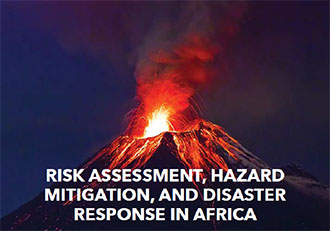
The Editor-in-Chief of African Technopolitan, a magazine of the African Centre for Technology Studies and with approximately 100,000 subscribers worldwide, asked Giday WoldeGabriel (EES-14) to contribute to a special issue on Harnessing Applications of Science, Technology, and Innovations for Sustainable Development in Africa. Giday’s article, titled “Risk Assessment, Hazard Mitigation, and Disaster Response in Africa,” explores the role of both natural and human-induced disasters in the economic growth and stability of the African continent.
The African continent is highly vulnerable to both natural and human-induced hazards. WoldeGabriel created a map of the major urban centers in Africa and the locations of potential hazard occurrences. He also catalogued the major natural and human-induced hazards that have impacted Africa in the past and are likely to do so in the future.
Natural hazards in Africa include geological (volcanoes, earthquakes, landslides, and tsunamis), hydro meteorological (floods, extreme heart, droughts, and wildfires), and biological (epidemics and pest infestations). Human-induced hazards include atmospheric (air pollution), water contamination (mine waste and irrigation outflow), fires (slash and burn), land (toxic-waste and mining dumps), societal conflicts and terrorism (armed conflicts, genocide, and biological threats), and technological hazards (hazardous materials). All of these disasters could significantly impact Africa’s economic development, political stability, social order, and peace. Assessing the risk of each of these natural and human-induced disasters and developing a plan for mitigation and disaster response is essential. Mitigation seeks to reduce the risks of catastrophic impacts through careful planning, effective regulation of land use, and building procedures.
Some actions have already been taken to begin the risk assessment and hazard mitigation process. For example, the International Council for Science Regional Office for Africa has prepared a science plan for mitigating major hazards in Sub-Sahara Africa, and the World Bank has established a disaster risk management team for this same area. In addition to these national efforts, scientists from Africa, Europe, and the United States are trying to increase natural hazards preparedness in Africa through collaborative research, training, and mentoring. A geohazard PhD program was planned at an African University, but the program stalled due to a lack of adequate resources.
WoldeGabriel recommended a number of additional steps for African countries to increase their hazard preparedness and risk mitigation. At the continental level, the Department of Human Resources, Science, and Technology of the African Union could play an important role as the coordinator of national, regional, and international efforts in hazard preparedness. At the regional levels, countries that are at risk for similar hazards and disasters should coordinate and integrate their resources. And at the country level, each nation should plan and develop a database of all potential natural- and human-induced hazards at the local, district, provincial, and national level.
WoldeGabriel concluded that the most important long-term option is to establish at least two Africa-based higher education centers to provide hydro meteorological and geological hazards studies and training. These two programs would create the foundation for long-term knowledge growth and capacity building in hazards and disaster risk mitigation in Africa. Development and implementation of an effective hazards and disaster risk and mitigation strategy relies on skilled local expertise.
Reference: “Risk Assessment, Hazard Mitigation, and Disaster Response in Africa,” African Technopolitan 3, 78 (July 2015). Technical contact: Giday WoldeGabriel
Intelligence and Space Research
Curiosity spots possible continental crust on Mars
Earth is usually considered to be the only planet with continents. No other planet has a mixture of oceans and land. Scientists have conjectured that Mars may once have had an ocean that dried and froze eons ago. A paper recently published in Nature Geoscience, using ChemCam data and images from the Curiosity rover, reports that Mars has the building blocks of a super-continent in its southern highlands.
Earlier ideas about the Martian crust were based on information from the previous Mars rovers, orbital data, and meteorites chipped off of Mars and flung to Earth. This information suggested that Mars rocks are dominated by relatively dense, dark-colored iron- and magnesium-rich basalts similar to the part of Earth’s crust that underlies the oceans. By contrast, Earth’s continents consist of less dense igneous rocks that are higher in silicon and aluminum, and replete with minerals like quartz and plagioclase feldspar. These produce the lighter-color igneous rocks of mountain chains like the Rocky Mountains or the Sierra Nevada.
Gale crater, where Curiosity has been exploring since 2012, is filled largely with sedimentary rocks left from a large lake that once filled the crater. However, the exploration team has found a number of igneous rocks and pebbles that were apparently washed down from the rim. The researchers reported the unexpected composition of these pebbles as part of a pair of papers on soils and conglomerate rocks early in the mission. The rover also stopped in front of one apparently igneous rock named Jake Matijevic shortly after landing. ChemCam, with its ability to laser-analyze anything unusual within the vicinity of the rover, steadily collected igneous-rock observations over the course of the mission since then. Some of these rocks look amazingly like rocks found on Earth, and ChemCam’s chemical analyses confirmed the similarities.
In the new paper, the authors reported geochemical data from more than 20 rocks that Curiosity’s ChemCam instrument probed as the rover traversed ancient terrain near Gale crater. The researchers found that the light-colored rocks are rich in silica and display a diversity of compositions. Some of the rocks are compositionally similar to some of Earth’s oldest preserved continental materials. The researchers suggest that the light-colored, silica-rich rocks may be remnants of an ancient crust on Mars analogous to Earth’s early continental crust. The researchers conclude that the light-toned igneous rocks found by ChemCam in Gale crater are largely representative of all of Mars’ southern highlands. This solves an important long-standing problem: the gravity observed from orbiting satellites indicated that the southern highlands are less dense than the rock types previously hypothesized to comprise Mars. With the more “continental” type of rocks proposed by the authors, this gravity problem is solved. The Mars rocks appear to have relatively little quartz, somewhat different from igneous rocks in terrestrial continents, and which made the new rock types difficult to spot from orbit. Although quartz is relatively easily detected from orbit, mineral spectrum of feldspar is notoriously difficult. The ground-based observations in the right location enabled the team to draw this conclusion.
Photo. Igneous clast (rock fragment) named Harrison embedded in a conglomerate rock in Gale crater, Mars, shows elongated light-toned feldspar crystals. The mosaic merges an image from Mastcam with higher-resolution images from ChemCam’s Remote Micro-Imager. Credit: NASA/JPL-Caltech/LANL/IRAP/U. Nantes/IAS/MSSS.
This is the first discovery of a potential “continental crust” on Mars. The researchers suggest that the southern highlands appear to comprise a single large continent on Mars. The Earth similarly had just a single continent called Pangaea between 510 and 180 million years ago. Scientists had previously thought that continental crust, which is less dense and has a composition different than the crust beneath Earth’s oceans, was unique to Earth. The attributed it to complex magmatic processes possibly related to the onset of plate tectonics on Earth. The Martian crust was not assumed to have undergone such magmatic processing and therefore should consist of predominantly basalts, although recent orbiter and rover missions have spotted isolated occurrences of silica-rich materials. The findings reported in the new publication add to mounting evidence that ancient Mars may have been more similar to ancient Earth than previously thought. However, plate tectonics caused a breakup into the separate continents the Earth has now. In contrast, plate tectonics on Mars was at most only very minimally active.
Reference: “In situ evidence for continental crust on early Mars,” Nature Geoscience 8, 605 (2015); doi: 10.1038/ngeo2474. The paper’s first author is Violaine Sautter, a Parisian member of the joint US-French ChemCam team. Contributing authors include Los Alamos ChemCam team members Roger Wiens and Nina Lanza (Space and Remote Sensing, ISR-2), Sam Clegg (Physical Chemistry and Applied Spectroscopy, C-PCS), and former LANL scientists David Vaniman, Sylvestre Maurice, Olivier Gasnault, Agnes Cousin, and Jeremie Lasue. Laboratory engineers [Steve Johnstone, Dot Delapp, Cindy Little, Suzi Gordon (Space Data Systems, ISR-3), Tony Nelson (Space Electronics and Signal Processing, ISR-4), Rhonda McInroy (C-PCS), and former LANL engineer Steve Bender] supported the operation of the ChemCam instrument. The paper also included images from the Mastcam (mast camera) and MaHLI (Mars Hand Lense Imager).
Los Alamos leads ChemCam with funding from NASA. The work supports the Lab’s Global Security mission area and the Science of Signatures science pillar through remote sensing for space situational awareness. Technical contact: Roger WiensPhysics
Mixed-material steady shock experiments at Omega Extended Performance Laser Facility
Los Alamos researchers have been developing a steady shock platform to examine the equation-of-state (EOS) characteristics of mixed materials under high-energy-density (HED) conditions. The platform is intended to provide measurements against which to compare the accuracy of several different EOS table mixture rules for mixed materials under high-pressure conditions. For example, Dalton and Amagat models are different rules for combining the EOS information for single elements to try to model the EOS of more complex mixed materials. Benchmarking these mixture rules provides information on the accuracy of simulations of multi-component regions present in HED and inertial confinement fusion (ICF) systems. Highly accurate experimental data exist for some gas mixtures up to a few Mbar, but experimental data are sparse for higher-pressure systems with initially solid metal mixtures. It is in the greater than 10 Mbar regime, which is particularly informative for HED and ICF, where the various mixture rule predictions show increasingly larger disagreement.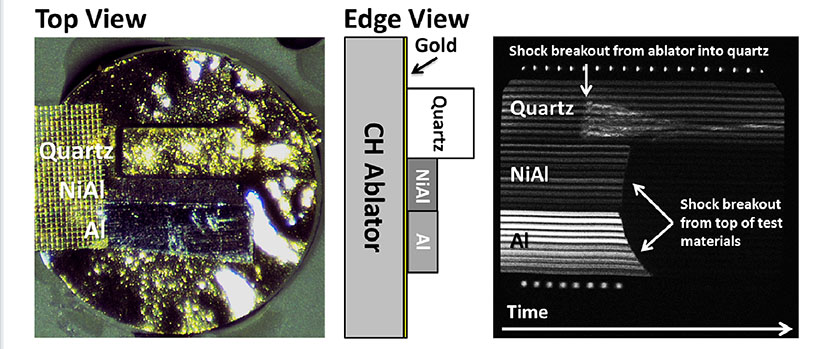
Figure 4. (Left): Top view of an as-built steady-shock target. (Center): Edge-on view of a target schematic. (Right): VISAR (velocity interferometry system for any reflector) data showing the shock breakouts into the quartz from the ablator and from the top surfaces of the nickel aluminum (NiAl) alloy and Al. The small observed change in the fringe signal after the breakout into the quartz indicates steady shock velocity.
Los Alamos researchers performed a first round of experiments at the Omega EP (Extended Performance) Laser Facility in Rochester, NY to evaluate the efficacy of a new directly laser-driven experimental platform. The team aimed to obtain accurate enough measurements to distinguish between mixture models. In these platforms, direct laser irradiation ablates away a layer of low-density hydrocarbon material and launches a high-pressure shock into a target material. These experiments featured two target types using a NiAl alloy for a test mixed material, as well as Al and quartz witness materials for which the EOS measurements are already well known. The first target type used a more standard design with a thin layer of ablator material and a thick layer of test material. The thick material has the potential advantage of increasing measurement accuracy by increasing the amount of material the shock propagates through before measurement. However, the thin ablator layer can introduce oscillations in the system’s post-shock pressure. The second target type used a thick ablator layer and a thin test material layer. The thick ablator layer is designed to increase the measurement accuracy by eliminating pressure oscillations, but it requires a thinner corresponding test material layer to reach the desired pressures with the same available laser energy.
VISAR (velocity interferometry system for any reflector) measurements of the steady-shock (thick ablator) targets captured the experiment breakout-times for the various test materials. The measurement also showed little fringe movement, after the initial fringe jump, from the shock propagation in the quartz. This result is indicative of little change in the shock velocity, and thus the desired steady-drive, over the course of the experiment. Researchers are making target improvements to enhance the measurement accuracy by both increasing the signal from the quartz witness and mitigating shock front curvature in the diagnostic field of view.
The Los Alamos research team includes Elizabeth Merritt and Eric Loomis (Plasma Physics, P-24), Joyce Guzik (XTD Nuclear Threat Assessment, XTD-NTA), and Derek Schmidt, Tana Cardenas, Lynne Goodwin, Gerald Rivera, Deanna Capelli, and Frank Fierro (Engineered Materials, MST-7). Science Campaign 10: Inertial Confinement Fusion (Program Manager Steve Batha) funded the work, which supports the Lab’s Nuclear Deterrence mission area and the Science of Signatures science pillar through investigations of materials at high energy-density regimes. Technical contacts: Elizabeth Merritt and Eric LoomisScience on the Roadmap to MaRIE
PHELIX at pRad enhances movie-making of materials in extreme environments

Photo. The PHELIX transformer with the liner load cassette at the center. The photograph was taken during initial testing prior to installation into the boxcar. The black coaxial cables connect the transformer to the capacitor banks (not shown).
A new pulsed power driver for the Proton Radiography Facility (pRad) at the Los Alamos Neutron Science Center (LANSCE) is producing images of higher spatial resolution than previously attainable, serving as a valuable tool for scientific experiments key to understanding and maintaining the U.S. nuclear stockpile.
PHELIX (Precision High Energy Density Liner Implosion eXperiment) is an air-insulated capacitor bank that provides greater than 400 kJ of stored energy, generating peak currents above 5 MA to implode centimeter-size liners in 10-40 μs, attaining speeds of 1-4 km/s. The experiments are self-confined. Researchers can tune the magneto-hydrodynamic push on the liner to match experimental needs via adjustments of the charge voltage for each shot. PHELIX combined with proton radiography technology produces more than five times the axial imaging data at higher spatial resolution in one experiment than was available with Atlas, LANL’s previous pulsed power facility for liner-on-target experiments.
David Oro (Neutron Science and Technology, P-23) gave an invited talk featuring this capability at the Shock Compression in Condensed Matter conference in Tampa, FL. Damaged surface hydrodynamic experiments performed with PHELIX explored shocked-ejected particle transport into gas in converging geometries. Researchers employed a cylindrical liner-on-target configuration for these experiments. The scientists used micron-sized tungsten particles in place of shock-formed ejecta to control the initial conditions. A 100-μm thick layer of tungsten powder coated the inner surface of the cylindrical target. The liner impacts the target, generating a shock that launches the tungsten particles off the target surface. The researchers captured the time history of the trajectory of the converging shocked-ejected particulate in 21 proton radiographs recorded during the experiment.
The team has executed three experiments of this type: 1) into vacuum, 2) into argon at 8.3 bars, and 3) into xenon at 8.3 bars. The image quantity and quality from pRad provide a level of detail in time and space that was not available previously for these types of experiments. The experiments employ pRad’s X3 magnifier. PHELIX can also be operated with the X7 magnifier to trade off field-of-view for higher resolution. Study of the details of hydrodynamically evolving features under extreme conditions is important for validating hydrodynamic algorithms in weapons computer codes. PHELIX gives researchers another tool to achieve these conditions in a controlled fashion that is compatible with advanced diagnostics such as pRad. PHELIX has the advantage of its small size (approximately that of a travel trailer), which can be placed in the pRad beamline for experiments and removed to make way for others. The Laboratory’s previous pulsed power machines, Atlas and Pegasus, required large rooms and fixed positioning.
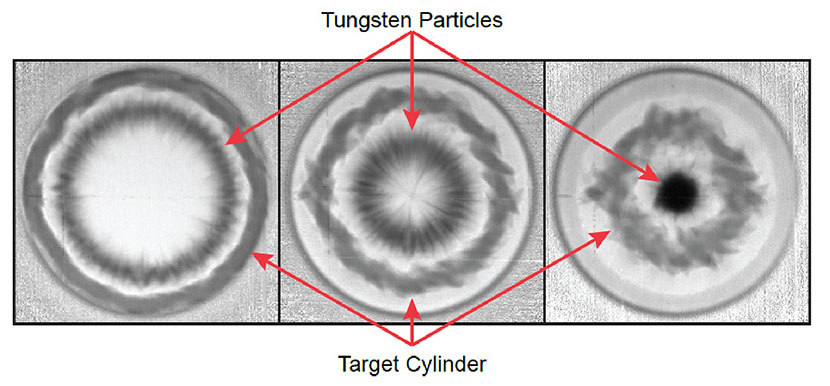
Figure 5. Three of the 21 proton-radiographs taken down the liner load central axis during the experiment. (Left to right): the images were taken at approximately 30 μs, 34 μs, and 39 μs after the start of current flow. In the first image, the cloud of tungsten particles and target cylinder enter the field of view. In the second image, the fastest traveling particles have reached the center. In the third image, most of the tungsten particles have accumulated at the center.
The work is an example of Science on the Roadmap to MaRIE, the Laboratory’s proposed Matter-Radiation Interactions in Extremes facility that would provide the capability to image over microseconds timescales thick samples of materials undergoing a dynamic event.
Funded by Science Campaign 1: Primary Assessment Technologies (LANL Program Manager Stephen Sterbenz), the creation of PHELIX involved a collaboration of the Laboratory’s Physics, Computational Physics, Accelerator Operations and Technology, and Materials Science and Technology divisions; and National Security Technologies LLC. The pRad capability is primarily funded by the NNSA Science Campaigns. PHELIX supports the Lab’s National Security mission area and the Materials for the Future and Science of Signatures science pillars through investigation of shock-ejected particulates. Technical Contact: David Oro











